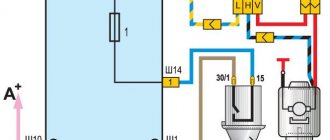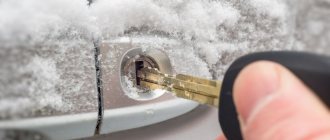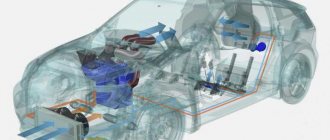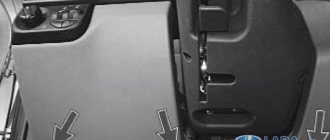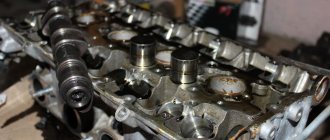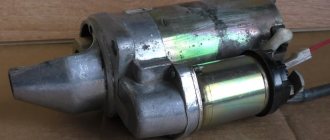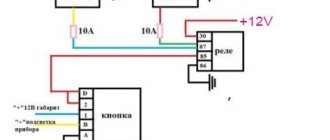Air conditioning is an almost integral part of every car these days. Unfortunately, the car air conditioner can fail, and for this reason the driver must know how to repair it. If the car is new, the air conditioner should work for a long time, but if your car has a high mileage, then you will encounter this problem often. What to do when the air conditioner in your car does not work, and how to make it work? In this article I will tell you how to deal with such situations.
Checking the performance of the car compressor
You can check whether the compressor itself is working using a pressure gauge, but the check should be carried out in a specialized car service center using special equipment:
- we connect the installation to the car’s air conditioning system, start the engine;
- turn on the air conditioner, watch the pressure gauge readings, the pressure on the device with a working compressor should increase;
- if the pressure rises, the compressor is in order, and if there are faults in the system, they must be looked for in other elements of the air conditioner.
Main causes of breakdown and wear
The main reasons for wear of the connecting rod and piston group:
- lack of refrigerant (leakage or untimely refilling);
- not enough oil or the wrong type of oil;
- too high pressure (overheating or excess freon);
- dirt and water in the system;
- broken bearings or internal play of parts.
It is worth noting that the pressure in the system may be increased due to poor heat transfer if dirt has accumulated between the radiator fins. Regular cleaning and flushing of the radiator can significantly extend the life of the compressor.
Possible causes of malfunction of the electromagnetic clutch (pulley slippage):
- The gap between the pressure plate and the pulley is too small. The disc clings to the pulley when the air conditioner is turned off, which leads to wear of the friction surfaces).
- The gap is too big. When the electromagnet is turned on, the disk is weakly pressed against the pulley. The result is the same - surface wear (“burning”).
- Closing the electromagnet windings. If the fuse does not work, the coil burns out, emitting an unpleasant odor.
- Winding break. In this case, the electromagnet does not work, there is no current in the circuit.
Radiator fan does not work
The radiator-condenser has its own fan, which is responsible for additional cooling. Fan malfunctions are always electrically related, namely:
- bad contacts;
- relay malfunction;
- fan motor failure - this situation is extremely rare.
Diagnosis of air conditioner malfunction by a professional
Most often the problem is due to poor contacts. By the way, bad contacts can cause more serious damage, for example, a pressure sensor may stop working. If problems with pressure arise, an emergency release of refrigerant or even a line explosion may occur. Therefore, after winter it is necessary to carefully check all contacts of the air conditioning system.
Chevrolet Cruze Air Conditioning Stopped Working
Last year I was driving around the town and I saw that the Conder was not getting very cold, I said this to the OD and so they took it for diagnostics, I say it’s a brand new car, maybe they forgot to fill it or they didn’t pour enough freon, the master says to me the device died, drained the freon, poured it back, there was 600 grams of it all normal, change the cabin filter, I changed the filter and that’s it, but the problem is not solved anyway, it cools the air conditioner slightly, the color of the car is dark, what should I do, tell me, does this happen to everyone, or is it just me?
Mileage: 25000 km
Chevrolet Cruze 2011, 141 l. With. - observation
Hi all! I have a Chevrolet
Cruz.
1.8 automatic transmission. The air conditioner
is running. It blows cold, it blows hot. The air conditioner stopped working - Chevrolet lovers club. I touched the tubes and they were hot. I look at the belt and it looks normal.
Air conditioning for Chevrolet Cruze, the auto-closer stopped working. I looked at the lower pulley and sometimes it will stop spinning. In general, I bought a Chevrolet Cruze and it recently stopped working because the air conditioning was weak.
What to do? What is the reason? How to fix? Please tell me, it’s 38 degrees outside.((((
Hi all
!
If you want to check the presence of gas in the system, just touch the pipe on the compressor while the air conditioner is running; if it’s cold, then everything is fine)). And the air conditioner should work
with the air damper closed and nothing else.
How does a car air conditioner work?
The operating principle of any air conditioner is not much different from the operating diagram of a refrigerator - in both cases we are dealing with closed, sealed systems that use a certain refrigerant, which is a substance in a gaseous state. When the climate system is turned on, the compressor starts, compressing the refrigerant. It is known from the laws of physics that as pressure increases, gas heats up. Rushing in a heated state into the condenser (popularly called the “air conditioner radiator”), the refrigerant cools, turning into a liquid state. After this, its path goes to the receiver-dryer, where liquid freon is filtered from various contaminants and enters the thermostatic valve, where it again turns into a low-temperature gas.
Finally, the cooled refrigerant enters the evaporator, where it interacts with the air coming from the passenger compartment, cooling it. Here, the moisture present in the air flow settles on the cold radiator tubes and flows down, where a drain tube is installed to remove condensate outside. Meanwhile, the fan supplies cooled air purified from excess moisture back into the cabin. After the evaporator, the freon flows back into the compressor, completing a continuous cycle.
Damp smell when air conditioner is running
When freon evaporates, the evaporator (air conditioning radiator) installed in the car interior cools. Condensation (dew) forms on cold metal - this is how the air gradually “dries” when the air conditioner is running. During normal operation of the air conditioner, only excess moisture is removed from the air, making the microclimate inside such a car much better than with open windows. In addition, this prevents the windows from fogging up.
Any air conditioner has special drainage channels for draining and discharging condensate to the street. Therefore, a puddle of water forms under a car parked with the air conditioner on. But over time, the drains become clogged with dirt, fluff, and particles of leaves, and water begins to accumulate inside the evaporator box. The windshield begins to fog up when the air conditioner is running. On some cars, this water spills onto your feet when making sharp turns.
Due to the increased humidity in this mud substrate, which clogs the drainage holes, bacteria and fungi begin to multiply. This increases the unpleasant odor and also causes illness. In the vast majority of cases when a person catches a cold from an air conditioner, it is not hypothermia that is to blame, but rather the lack of timely sanitation.
Sometimes they are treated with dry fog or special sprays, foam sprays, and so on. In this format, there are special antiseptic compositions for sanitizing the climate system, but in most cases, such actions are simply trying to hide the unpleasant odor. Without cleaning the drain holes, such treatment simply does not make any sense.
We repair pipes and hoses
Any air conditioning system on a car includes pipes, rubber gaskets, seals, and line hoses. All of them are connected into a single system, with a front and rear circuit, ensuring its tightness. If one of the elements becomes unusable, then depressurization occurs, water drips and the air conditioner does not work well. After a visual inspection and detection of refrigerant leaks, you need to replace the damaged parts of both the front and rear circuits and top up the system with freon.
We recommend: Replacing the fuel pump on a VAZ-2113, 2114, 2115
Small cracks in aluminum tubes can be repaired with your own hands without tools by treating them with special compounds. They are used to solder cracks in the form of patches. The mixtures are applied to the holes in several layers, the thickness of which is 2-3 mm. If the cracks are large - 2-3 mm wide, then repair of car air conditioners is carried out using argon-arc welding. It is necessary to purchase special tools: a pipe bending machine, a pipe cutter and a welder. Instead of a pipe cutter, you can use a metal file.
In order for the parts of the front and rear circuits to remain elastic, it is necessary for preventive maintenance to constantly use the air conditioner, even in winter, and monitor its cleanliness.
Air conditioning system assembly
Useful tips
Evaporator
Note: As the air passing through the evaporator cools, the water vapor it contains condenses.
The condensate is drained through a drain pipe located under the lining in front of the central floor tunnel under the bottom of the car. If the ambient air humidity is high, a puddle of water may form under the car, which is an indirect sign of the health of the air conditioning system. Helpful advice: During the operation of the car, particles of road dust and dirt settle on the outer surface of the evaporator, damp from condensation.
Thermostatic valve Receiver-dryer
Warning: In case of repair or replacement of elements of the air conditioning system, if it was in an open state (any components were removed, pipelines were destroyed, etc.), the receiver-dryer cartridge must be replaced.
Otherwise, after charging the system, the refrigerant will not be dried and acids may form inside the system, which will destroy the air conditioner parts from the inside. Pipelines
Service valves
Note: This is how the service valves of the high-pressure lines are located on the pipelines...
...and low pressure (in the photo the valve is shown with the air filter housing removed). Warning: It is prohibited to check the presence of refrigerant in the system by pressing the service valve spools, since after such a check the valve spool may not close completely and refrigerant will leak from the system!
Pressure meter
Control unit
Heating, air conditioning and interior ventilation Note: The interior air temperature sensor is located in the instrument panel (in the heater housing). To eliminate incorrect temperature readings due to the influence of heated panel elements, the sensor is equipped with a forced airflow system. The system ensures a uniform flow of air from the front of the vehicle through the sensor housing. To ensure proper air movement, protect the sensor housing inlet from any solid particles or liquids. This is especially true in cases of dry cleaning of the interior. When cleaning the interior with a vacuum cleaner, it is strictly forbidden to bring the suction tip of the vacuum cleaner pipe to the sensor inlet. If air flow through the sensor housing is obstructed, the normal functioning of the automatic climate control system is disrupted.
Outdoor temperature sensor
Solar sensor Refrigerant
- refrigerant R 134a, kg - 0.65
- PAG oil, ml – 180±5
Notes: During the operation of a car air conditioner, situations periodically arise when the air conditioning system requires servicing or repair. For this purpose, modern diagnostic and repair equipment is used. The most common situation is the depressurization of the system and the release of refrigerant from it. To detect leaks, highly sensitive halogen leak detectors with sound indication are used. In some difficult cases, the method of so-called ultraviolet diagnostics of the tightness of the car air conditioning system is used. The method consists in introducing microdoses into the system. special dye. In places of micro-leaks, the dye, together with the refrigerant, gradually reaches the outer surface of the system elements. During inspection of the system, the dye, under the influence of ultraviolet rays of a special lamp, begins to glow (fluoresce) ...... and the places of refrigerant leakage become visible. It should be noted that the dye does not have any negative effect on the system. It can remain in the refrigerant and circulate through the system for as long as desired and will serve its purpose only when a leak occurs. After repairing the car air conditioner, it is necessary to evacuate and charge the system with the appropriate refrigerant (R134a). To refill a car air conditioner with high quality, you need: Warning: The air conditioning system is charged with high pressure refrigerant. Contact of liquid refrigerant on human skin causes severe frostbite, therefore, if possible, carry out all work related to the maintenance, repair or dismantling of air conditioning system elements in specialized service centers equipped with professional technological equipment
When carrying out work on your own, take precautions.
Compressor repair
Before repairing the compressor, you need to stock up on the necessary tools. To repair the compressor you will need:
- Ohmmeter
- Fluorescent paint
- Screwdriver
- Ultraviolet light bulb
So, let's look at the instructions:
To make sure that it is the compressor that has broken down, you need to check its fuses. In case of malfunction, they must be replaced. If the fuses are OK, you need to continue troubleshooting.
The second step is to check all the wires that connect to the compressor. You also need to check the fastening and tension of the belt. If a problem is found in these places, it must be corrected by tensioning the belt or replacing the wires.
You should also check the electromagnetic clutch. Its diagnosis and repair is carried out in the following order: first, the presence of lubricant on the rotor and on the pressure plate is checked. Next, the bearing is checked for lubricant leaks and for the presence of extraneous noise. Using an ohmmeter, the resistance on the coil is checked. If necessary, it must be replaced if the resistance is below normal.
If the drive pulley bearing has failed (this can be determined by the appearance of third-party noise when the car air conditioner starts to operate), then in this case it needs to be replaced with a new one.
Next, I recommend checking the refrigerant in the compressor for leaks. This check can be done using a fluorescent lamp. It can be purchased at almost any auto store. It must be placed in the low pressure hole located in the air conditioner canister. Next you need to wait a little. After this, the air conditioner can be carefully inspected using an ultraviolet lamp.
The final action will be to repair mechanical damage to the body. To seal them you will need welding. After this, the compressor must be refilled using a new refill kit.
If you have identified errors and carried out independent repairs, and the problem has disappeared, but not completely, then in this case you should seek help from a specialist. Be sure that after the specialist, your car will work in a completely new way, and the car air conditioner will be turned on by you and will not turn off spontaneously. Remember that it is negligence and ignorance that causes rapid wear of the compressor, and as a result, frequent repairs.
We recommend: How to properly remove tinting from car windows and headlights? 4 effective ways
If the compressor fails
It happens that the button works, the amount of refrigerant is sufficient, but the device does not want to work. The air conditioning compressor most likely does not turn on here. It may not work due to a loose or broken drive belt. Also, the compressor will not turn on if there are refrigerant leaks. But the causes of leakage can be various defects on the device body, a broken line, or a worn rubber gasket. These are the main reasons when it is impossible to start the air conditioning compressor.
Next, it is recommended to carefully inspect the unit body. There should not be any drips on it. There could be an oil or refrigerant leak. If drips are visible, this is a reason for a serious inspection. For more accurate diagnostics, the unit is removed from the car. Defects in the housing through which the refrigerant escapes cannot be repaired. The device should be replaced with a working one. Experts say that modern car air conditioners are difficult to repair, and most components are completely disposable.
It is also recommended to diagnose the gasket. There should also be no freon residues on it.
How to check the operation of the Renault Logan air conditioner
If the air conditioner does not turn on or does not cool enough, you need to diagnose the air conditioning system. First you should check the gas pressure (freon), the check is carried out using a special pressure gauge. There are fittings for installing a pressure gauge; they are located almost on the bends of the tubes in the area of the right side member.
You can also check the presence of refrigerant by pressing the valve in the fitting, which is located under the cap. If the air conditioner is charged normally, when you press the valve, gas under pressure will exit the system and it will hiss.
If gas does not come out, there is a leak in the system - it must be found and the malfunction repaired. After eliminating the freon leak, the system should be refilled with gas. There are ways to independently refuel an air conditioner with freon, but it is still recommended to refuel at special stations in a specialized car service center.
In some cases, the car is fully charged with freon, but the air conditioner does not turn on. It should be noted that the clutch may not engage for several reasons, and the defect is not necessarily hidden in it. Reasons for clutch failure:
- there is a break in the wires, power is not supplied to the compressor;
- The power relay does not work; on Renault Logan it is located in the mounting block, in the engine compartment on the left side (near the battery).
Checking the relay is quite simple - you need to dismantle it, connect the contacts under it with a piece of wire, and press the button to turn on the air conditioner. If a loud click is heard when the connection is made, this indicates that the A/C clutch is working properly and the relay needs to be replaced.
If there is insufficient cooling of the air inside the car, you should diagnose the equipment at a car service center on a stand and check what pressure is in the system. The pressure must be certain, not lower or higher than the prescribed norm.
The air conditioner may not cool the air enough if the condenser (radiator) is clogged with dirt. When air is not supplied to the radiator cells, the system is not cooled sufficiently and it does not work efficiently. On Renault Logan, the condenser is located at the front of the car, and to clean the radiator from the outside, you need to remove:
- radiator grille;
- front bumper;
- electric cooling fan.
It is not advisable to disconnect the condenser from the tubes, since in this case the car will have to be refilled with freon. The following elements may also be faulty in the air conditioning system:
- receiver-dryer, signs of its malfunction - spontaneous shutdown of the air conditioner, freezing of hoses in the system;
- thermostatic valve - if it is defective, cold air enters the cabin intermittently;
- pressure sensor - if it is faulty, the air conditioner is unstable;
- evaporator - when clogged, an unpleasant odor appears in the cabin.
When buying a used Renault Logan, it is recommended to go for diagnostics to a car service center and check the operation of the air conditioner using special equipment.
We recommend: Replacing the crankshaft oil seal Lada 2107 (VAZ 2107)
Car air conditioner diagnostics
Automakers started equipping cars with air conditioning back in 1933. However, the first copies equipped with them appeared only in 1939. These were Packard devices, and they were assembled by hand. It should be noted that these devices were not highly reliable, had high cost and low efficiency. At the same time, the first climate system occupied space under the hood in the car’s interior, as well as half the volume of the trunk.
Nowadays everything is much better with these devices. They have become much more compact, their efficiency has increased significantly, as has their reliability. But every now and then motorists encounter problems in their work. Let's see how to diagnose the air conditioner in a car.
How does a car air conditioner work?
In automobile climate control systems, this device is integral with the ventilation and heating of the interior. The operating principle of this device is completely similar to how an ordinary refrigerator works.
But the peculiarity of air conditioners in cars is that not electricity is used as power, but a little power from the engine. Thus, energy is transferred from the crankshaft using a drive belt.
By design, a car air conditioner is a sealed system filled with refrigerant and oil, which lubricates the system and the compressor.
Principle of operation
When the driver starts the climate system, a special electromagnetic clutch attracts the pressure plate to the pulley. This pulley rotates constantly from the drive belt.
After this, the compressor starts and the refrigerant begins to move through the pipelines until the freon reaches the condenser. The condenser is designed to cool the heated refrigerant. This part is located near the radiator in the engine compartment - an electric radiator fan helps cool the freon. When the refrigerant has cooled sufficiently, it enters the receiver as a liquid. The latter is used as a filter. It cleans condensate and removes dirt and particles from it that are a result of wear. The liquid is then directed to a special thermostatic valve.
This unit is actually an automatic throttle. It supplies the condensate to the evaporator in a gas state. The evaporator, through which almost ice-cold freon passes, cools down and is sufficiently cooled. And thanks to the fan, this cold can fall into the cabin. Next - the next lap and until the driver turns off the system.
How to diagnose an air conditioner
Before you look for problems in the inside of the device, try to inspect the condition of the external parts as carefully as possible. This must be done to detect possible mechanical damage. If you haven't found anything, it's too early to rejoice. A popular failure is a leak. You need to find her.
How to detect a leak in an air conditioner
Several decades ago, such diagnostics of an air conditioner for leaks was carried out using a special small gas burner. The whole point here is that freon has a special property. When detected, the flame changes its color to green.
It must be said that the method is not only ineffective, but also quite dangerous. When this substance burns, it releases a very dangerous poison - phosgene.
Arming ourselves
Today, leak detection is performed in two ways. So, there are special devices - electronic leak detectors. You can also use ultraviolet light.
A leak detector is a special device that detects freon vapors in the air. The sensitivity of these devices is sufficient to detect leaks in amounts of 5 to 10 grams per year. The market offers many different models of these devices. Most of them are quite simple in functionality and suitable for home use. With this device, diagnosing your car's air conditioner yourself becomes much easier. Others are more intellectual. But the device does not provide any guarantee that a leak will be detected immediately. This device can only detect a cloud of freon.
It happens that you may think about one pipe, but another leaks. Such diagnostics of an air conditioner is especially difficult when the tubes are located almost next to each other. Only extensive experience in such research can help here. You can also use the exclusion method - all tubes are removed and checked one by one.
UV power
But even with leak detectors, holes are not always detected. It often happens that freon decreases over several months and only at certain pressures. Or, for example, places where leaks occur very often are located very close to each other. The device senses the proximity of gas, but cannot find a specific place.
Then it’s worth taking advantage of the opportunities that ultraviolet radiation provides us. Such diagnostics of a car air conditioner helps to more accurately detect harmful and elusive leaks.
The essence of this method is the use of dye. The system must be fully charged, but along with freon and oil, a special substance is also added, which gives a bright glow in ultraviolet rays. The dye will not affect the operation of the system in any way, there is nothing to be afraid of. Most manufacturers add dye to their systems during production. It is very important that the fuel is fully charged.
There should be no desire to save money here, otherwise all this do-it-yourself car air conditioning diagnostics loses its meaning. There is also a risk of premature “death” of the device.
After refueling, you can drive and use the climate control at full capacity. When you feel that the unit has become worse, then you need to put the car in the garage and illuminate all the pipes and lines with a special lamp. To get an accurate result, it is advisable to work in dark rooms. You can easily see the places where freon leaks. They will glow poisonous yellow with smudges or nebulae.
Advantages and disadvantages
But for all its advantages, this method also has disadvantages. So, not all tubes can be seen - such diagnostics of the air conditioner requires the dismantling of some components or sections of the system. Among the most difficult to reach places is the evaporator, which is hidden deep in the dashboard. So that you don't have to disassemble half the car, you can diagnose the drain pipe. If it doesn't work, try using a leak detector.
If the system on the car has already been dismantled and disassembled, and dye has been added to it, then there is a risk that the diagnosis of the car’s air conditioner will not be accurate.
It even happens that the first time you may not find anything at all. The electronics see nothing, the dye is invisible to the eye, and the refrigerant leaks somewhere. If you have any doubts about this, it is better to use two methods during diagnostic procedures.
Testing the compressor
Diagnosis of a car air conditioner also includes checking the operation of the compressor. During the test, it is necessary to find out how efficiently the unit operates. The malfunction of this unit can be determined by its sound - it makes unnatural noise during operation.
There is another option for checking the compressor. Start the air conditioner, then when the compressor starts running, grab the metal part on the return line with one hand. For effect, grasp the knot firmly with your whole hand. After a couple of seconds, your hand will feel like the tube will literally start to freeze. Everything is fine if you feel like you’ve picked up an icicle. The ideal job is if the cold causes the bones of your hand to cramp. This diagnostic of the air conditioning compressor will help you find out whether this unit is broken or working.
In addition, it is also necessary to diagnose all electrical components of the air conditioning in the cabin. These are various couplings, sensors, fans.
How to check for leaks
This is a simple way to find out if there is a lot of freon in the system. To do this, you just need to look through the so-called window. You can find it in the dehumidifier area. This window is not available on all devices, but if it is, you can get all the information about the status. If the refrigerant has turned white and there are bubbles in it, then further, more complete diagnostics and refilling of the air conditioner are required. When the refrigerant is in the correct state, it is clear and has a uniform consistency.
Typical malfunctions of car air conditioners
Compressor and depressurization are not all that can happen to the air conditioner in your car. Many of the breakdowns can be detected independently.
For example, among other faults, a breakdown of a condenser or radiator is considered quite serious. If it really doesn't work, hot air will be blown into the cabin. The main reasons for this annoying breakdown are dirt. It is imperative to eliminate this malfunction, otherwise you will face serious consequences in the future.
The evaporator also often fails. This happens because the part is corroded. The culprit is the same dirt that clogs the tubes through which condensate can drain. Diagnosis of an air conditioner malfunction in this case is based on the appearance of an odor in the cabin, low operating efficiency, and water.
Also among the typical malfunctions are problems with the receiver and thermostatic valve. These breakdowns can lead to serious consequences. Try to pay more attention to your car. Then it will not upset you with breakdowns, and your ride will be comfortable and cool.
The air conditioner does not turn on - looking for reasons
The most serious failure is a jammed compressor. It manifests itself in different ways:
- a grinding or rumble is heard from under the hood, sometimes smoke even starts pouring out;
- the compressor drive belt, which drives it from the engine, breaks or jumps off;
- The safety plates on the pulley break, a quiet click is heard, and the air conditioner simply stops working.
There are several reasons for compressor failure. Most often, it breaks down as a result of prolonged operation with a clogged radiator - high pressure and elevated temperature greatly reduce the service life of the compressor. Therefore, the radiator must be cleaned every year.
Another common cause of compressor failure is lack of lubrication and dirt. This occurs as a result of depressurization of the system - a burst tube, cracked housing or worn gasket leads to the penetration of moisture from the atmosphere. As a result, corrosion and dirt appear, which damage the unit.
The most common reason for the air conditioner not turning on is a clogged radiator.
Keep in mind that the compressor may fail if, after depressurizing the system, you repair the problem and immediately charge it with refrigerant. This especially happens in cases where the car has been operated for a long time with a depressurized system. The fact is that after any depressurization, the system must be flushed, since any dirt is destructive for the compressor.
It is forbidden to use the air conditioner without flushing after a long period of inactivity, as this can also lead to compressor failure.
Filter clogging
The air conditioner, having a simple system, has a whole system of filters that provide a flow of cold or warm air. They purify the liquid and remove moisture from the system. It is the clogging of the filters that can lead to a malfunction of the air conditioner in the car. Initially, performance will simply drop, and then complete failure will follow.
Filters require special attention after refilling the air conditioner.
After detecting signs of a malfunction of the air conditioner in your car, it is important to promptly contact a car service for diagnosis, refueling or repair. Timely professional service is the key to success and relative savings. Prices for air conditioner repairs at a car service center depend on the complexity of the work performed.
Methods for flushing the air conditioner
A car wash does not always help get rid of contaminants from the climate system, which can cause various problems. If you notice that the air conditioner in your car is not cooling, most likely it is simply dirty. Therefore, it is recommended to periodically flush the air conditioner yourself. This procedure, although it will require partial disassembly of the system, will allow for much better cleaning.
To do this, you will need to remove the condenser from the mounts and unfold it a little to gain good access to both the inside of the condenser and the space between the radiators, where a lot of dirt also accumulates. To wash, you can use dishwashing detergent, which should generously moisten all radiator tubes and give the chemical time to absorb (10 - 15 minutes is enough). Then you should rinse the radiator with a stream of water, which must be directed strictly at a right angle. The pressure should be small - otherwise the risk of damage to the radiator honeycomb increases.
The degree of cleanliness can be determined visually; if all the dirt is not washed off, the procedure must be repeated. If you notice bent (crumpled) honeycombs, you need to carefully straighten them using a wooden (not metal!) stick, after which you can remove the remaining solid fragments (twigs, pebbles, insect remains).
Performance assessment
In the air conditioning system, the components most susceptible to wear are the compressor and heat exchanger. When the question arises - why the air conditioner in the car does not turn on, you should make sure there is no contamination and assess the level of the working fluid. You can also carry out quick diagnostics by assessing the performance of the device.
How to do a quick assessment:
- Having started the engine, turn on the air conditioner;
- when you touch the thick tube, you should feel an increasing coldness;
- when turned off and then turned on, a cold wave should appear;
- at the same time, the thin tube becomes hot, its temperature should increase along with the ambient temperature.
When heat and cold are not clearly expressed, diagnostics and inspection at a service center are required.
Just add freon?
“Me too, they found the problem!” - some will say. And they will remember that they solve these issues at once: in the summer, mobile posts for refilling air conditioners are in full swing on the roadsides. I drove up and added freon right on the spot...
However, specialized experts say: if the air conditioner stops “cooling” due to a lack or absence of freon, this usually means that the car owner “missed” the moment and did not pay due attention to the system at an early stage of the problem.
Yes, freon can gradually leave even in a completely serviceable and sealed air conditioning system: an annual loss of 5-10% of the total filling volume is considered the norm. It is for this reason that it is recommended to check the “remainder” once every two years using a special installation.
And in older cars, there is a risk of loss of freon due to a leak in the system, usually due to through corrosion of the condenser, evaporator or connecting pipes. The external radiator also suffers from mechanical damage, because it is usually installed behind the radiator of the engine cooling system and is the first to take all the blows.
Need I say that in this case, simple refueling makes no sense? It is necessary to find the source of the leak, and the sooner the better. The lack of tightness of the air conditioning system can be detected even at the evacuation stage, which precedes refilling freon. But to more accurately determine the location of the leak, you can use the halide or ultraviolet method or a combination of both. In any case, this is a matter of work for specialists. It is important for the car owner to understand: if the freon is gone, first you need to figure out the reason.
What's the point?
To begin with, there is a background story in which the reason lies.
The beautiful interiors of modern cars, even expensive ones, contain quite a significant amount of plastic in the trim. When plastic is heated through glass, as if through a lens, a physicochemical reaction occurs, as a result of which, among other harmful compounds, a toxic carcinogenic substance, benzene, is released.
This poison can penetrate the body through intact skin, causing nausea and dizziness, allergies, drug addiction, and in severe cases, death. Numerous medical studies have established a connection between benzene and such terrible diseases as acute and chronic myeloid leukemia, aplastic anemia, and bone marrow diseases.
According to the American Cancer Society, the concentration of the carcinogen benzene in a car parked in the sun can increase 40 times, and tightly closed windows keep it inside. In addition, plastic is located under the hood, which also becomes hot, stimulating the production of toxins.
When you jump into the car and turn on the air conditioning at full power and maximum airflow, the first thing it throws at you is hot air with accumulated toxic substances from both the passenger compartment and the engine compartment. And since operating the air conditioner with the windows open in cars is not recommended in the same way as in rooms, a lot of time must pass for the air in the cabin to be “renewed” by mixing with the air outside.

